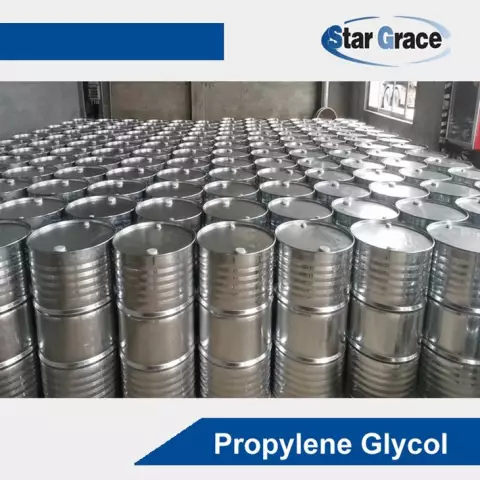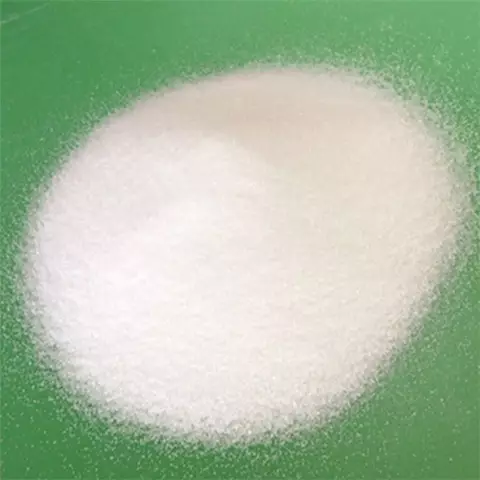- Author Rachel Wainwright [email protected].
- Public 2023-12-15 07:39.
- Last modified 2025-11-02 20:14.
Propylene glycol

Propylene glycol is a colorless organic compound, almost odorless, transparent, viscous with a mild sweet taste, also called 1,2-propanediol, propane-1,2-diol or α-propylene glycol to distinguish it from the propane-1,3- isomer diol (β-propylene glycol).
The industrial method for the production of propylene glycol occurs by means of propylene oxide. Various manufacturers use either a non-catalytic high temperature process from 200 ° C (392 ° F) to 220 ° C (428 ° F) or a catalytic method that runs at temperatures from 150 ° C (302 ° F) to 180 ° C (356 ° F)) in the presence of either ion exchange resin, or a small amount of sulfuric acid or alkali.
Propylene glycol can also be produced by processing glycerin and biodiesel.
Important! Purchase propylene glycol only from official distributors to avoid counterfeiting!
Propylene glycol properties
Propylene glycol is a hygroscopic, colorless liquid containing an asymmetric carbon atom, soluble in water, ethanol, diethyl alcohol, acetone and chloroform. It is non-corrosive, has very low volatility and very low toxicity.
Molecular formula of propylene glycol - C3H8O2, molar mass - 76.09 g / mol, density - 1.036 g / cm³, melting point - -59 ° C, 214K, -74 ° F, boiling point - 188.2 ° C, 461K, 371 ° F, thermal conductivity - 0.34.
Propylene glycol application
45% of the propylene glycol produced worldwide is used as a chemical feedstock for the production of unsaturated polyester resins. Propylene glycol reacts with a mixture of unsaturated maleic anhydrides and isophthalic acid to form a copolymer. This partially unsaturated polymer undergoes further crosslinking to form thermosetting plastics. Propylene glycol also reacts with propylene oxide to form oligomers and polymers that are used to make polyurethanes.
The use of propylene glycol is considered safe for the production of food and medicine. Food grade propylene glycol is used as an additive E1520, which is a solvent and preservative for food, and is also used in tobacco and animal feed, and is the main ingredient in e-cigarette liquids. The use of propylene glycol is also possible in the production of personal care products and cosmetics, such as elixirs and body lotions, shampoos, emulsions, pastes, creams and lipsticks.
The properties of propylene glycol to increase and decrease the temperature of liquids make it possible to use it in the formulations of anti-icing fluids for aircraft and antifreezes for cars, in air conditioning, ventilation and heating systems of residential premises, in food cooling systems and other heat exchange equipment.
Propylene glycol is widely used as a solvent in traditional medicine. Oral and injectable medicines such as Diazepam and Lorazepam are based on propylene glycol.
Propylene glycol harm
Food grade propylene glycol has been found to be non-toxic and safe to use, and does not cause serious side effects. However, propylene glycol causes serious harm to the body in plasma concentrations above 1 gram / liter, which requires an extremely high consumption of propylene glycol-based drugs for a relatively short period of time. Cases of propylene glycol poisoning are usually associated with either inappropriate intravenous administration or accidental ingestion of large amounts of propylene glycol.

Prolonged skin contact with propylene glycol is essentially non-irritating. Undiluted propylene glycol has minimal eye irritation and occasionally results in mild transient conjunctivitis. Propylene glycol vapor can irritate the eyes and upper respiratory tract. Inhalation of propylene glycol vapor does not pose a significant risk to humans, however prolonged exposure to propylene glycol mist for theatrical performance may irritate the respiratory tract.
Intravenous administration of large doses of drugs that include propylene glycol can lead to hypotension, bradycardia, T wave and QRS complex abnormalities on the ECG, arrhythmias, cardiac arrest, hyperosmolarity syndrome, lactic acidosis, and hemolysis.
According to a 2010 study by the Swedish University Karlstad, indoor air concentrations of platinoids, propylene glycol and glycol ethers are associated with an increased risk of respiratory and immune disorders. Frequent inhalation of propylene glycol esters has been shown to lead to asthma, hay fever, eczema, and allergies, with an increased risk ranging from 50% to 180%. This concentration is associated with the use of water-based paints and detergents that contain these components.
Found a mistake in the text? Select it and press Ctrl + Enter.






